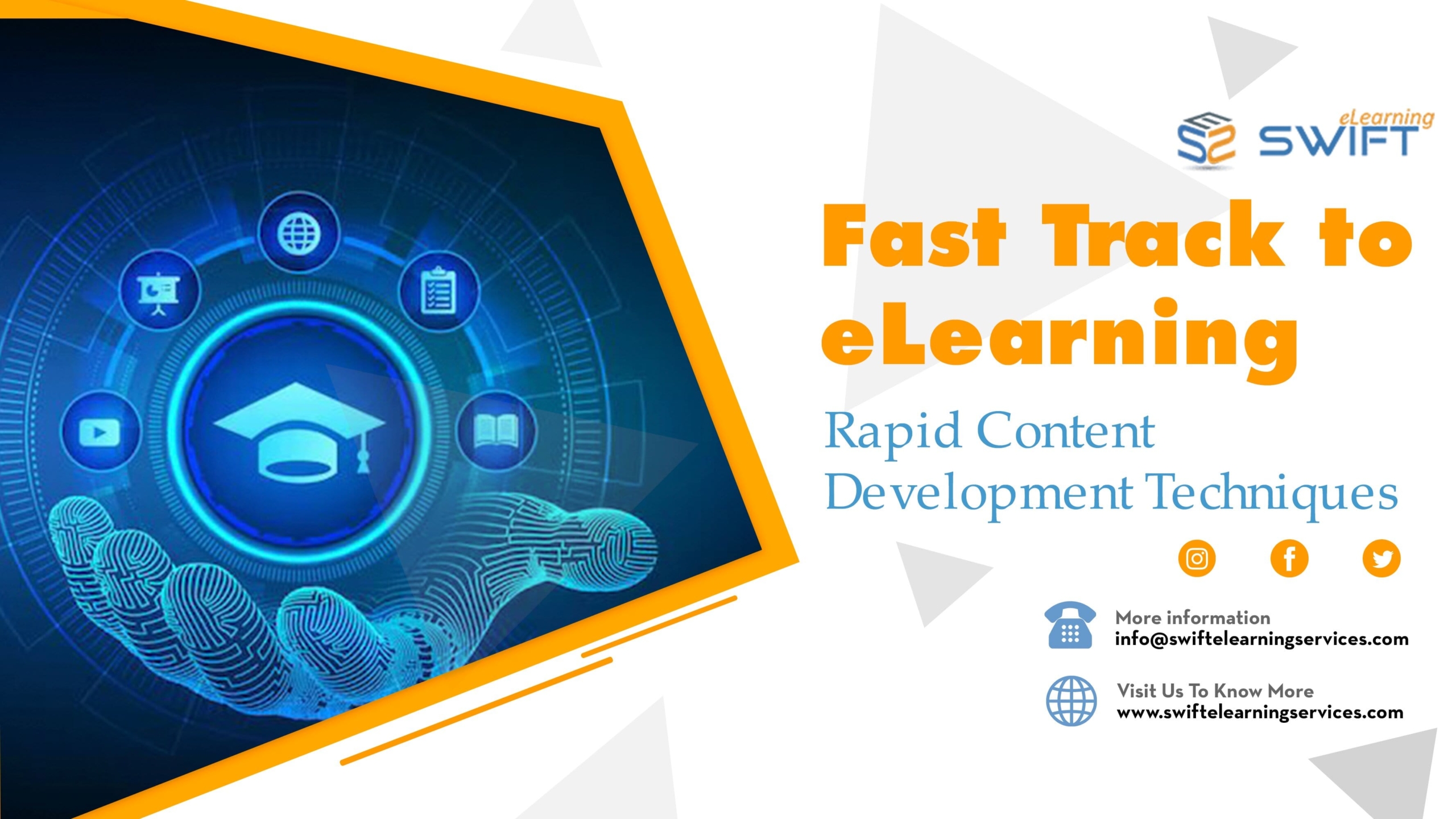Fast Track to eLearning: Mastering Rapid Content Development Techniques
Learn how to create engaging courses swiftly using top tools like Articulate 360, Adobe Captivate, and more. Accelerate your eLearning journey today!
In the dynamic world of eLearning, staying ahead of the curve requires agility and efficiency. Rapid content development techniques have emerged as a game-changer, enabling instructional designers and educators to create engaging and effective eLearning materials swiftly. In this blog post, we’ll delve into the world of rapid content development, exploring its benefits, best practices, and tools that can help you fast track your eLearning journey.
1. Benefits of Rapid Content Development
Rapid content development isn’t just about speed; it’s about maintaining quality while accelerating the creation process.
Here’s how embracing rapid techniques can revolutionize your eLearning projects:
1.1 Time Efficiency
Traditional content development can be time-consuming, delaying training delivery. Rapid techniques streamline the process, ensuring that time-sensitive information reaches learners promptly.
1.2 Flexibility
Rapid development allows for quick adjustments and updates, ensuring that content remains relevant in fast-evolving industries.
1.3 Cost-Effectiveness
By minimizing the time spent on development, rapid techniques can significantly reduce costs associated with eLearning projects.
1.4 Faster Onboarding
For new employees or learners, rapid development ensures that essential training materials are available promptly, accelerating the onboarding process.
1.5 Responsive to Trends
With the ability to swiftly create content, organizations can respond promptly to emerging trends and industry shifts, keeping learners up-to-date.
1.6 Customization
Rapid development allows for personalized learning experiences, catering to the specific needs and preferences of different learner groups.
1.7 Engagement Boost
By leveraging interactive elements and multimedia, rapid techniques enhance learner engagement and motivation.
1.8 Adaptability
Rapid content development facilitates the creation of bite-sized learning modules that can be easily adapted for micro learning initiatives.
1.9 Global Reach
Swiftly developed content can be translated and localized for different regions, enabling organizations to reach a diverse audience effectively.
1.10 Continuous Improvement
Rapid development encourages a culture of continuous improvement, as feedback can be quickly incorporated into updated content versions.
1.11 Reduced Downtime
For industries with strict compliance requirements, rapid content development ensures that employees are trained efficiently, minimizing operational downtime.
1.12 Skill Development
As content is produced more rapidly, organizations can offer a broader range of skill development opportunities, fostering employee growth.
1.13 Innovation Acceleration
Quick content creation enables organizations to experiment with new training methods and technologies, fostering innovation in learning.
1.14 Higher ROI
With shorter development cycles, the return on investment (ROI) for eLearning initiatives increases, as learners start benefiting from training sooner.
1.15 Crisis Response
In times of crises or sudden changes, rapid content development allows organizations to swiftly deliver essential information and training to employees or stakeholders.
These benefits showcase how rapid content development isn’t just about speed; it’s a strategic approach that aligns with the dynamic nature of modern learning needs.
2. Best Practices for Rapid Content Development
While speed is crucial, maintaining the instructional integrity of the content is equally important. Follow these best practices to excel in rapid content development:
2.1 Clear Learning Objectives
Begin with well-defined learning objectives. A clear roadmap ensures that you create content that aligns with the desired outcomes.
2.2 Storyboarding
Create a visual representation of the course flow, including interactions and assessments. Storyboarding clarifies the course structure and prevents hiccups during development.
2.3 Reuse and Repurpose
Leverage existing resources whenever possible. Reusing relevant content not only saves time but also ensures consistency across courses.
2.4 Collaboration
Collaborate with subject matter experts, graphic designers, and developers to streamline the content creation process. Effective communication expedites development.
2.5 Templates and Authoring Tools
Utilize eLearning authoring tools and templates designed for rapid development. These tools provide pre-designed layouts and interactions, saving you design time.
3. Tools for Rapid Content Development
Various tools are designed to facilitate rapid eLearning content creation. Here is a list of rapid content development tools:
3.1 Articulate 360
A comprehensive suite of eLearning tools that simplifies course development through templates, interactions, and collaboration features.
3.2 Adobe Captivate
Adobe captivate offers responsive design capabilities, simulations, and interactive elements to enhance learner engagement.
3.3 Elucidat
Elucidat focuses on collaborative authoring, enabling teams to work together seamlessly while creating interactive and engaging courses.
3.4 iSpring Suite
iSpring Suite is a PowerPoint-based authoring tool that allows users to convert presentations into interactive eLearning courses. It offers features like quizzes, interactions, and video narrations.
3.5 Lectora Inspire
Lectora Inspire is known for its robust capabilities in creating interactive and multimedia-rich eLearning content. It supports HTML5-based content creation and responsive design.
3.6 Camtasia
While often used for video editing, Camtasia can also be utilized for creating engaging video-based eLearning content. It’s suitable for screen recordings, tutorials, and demonstrations.
Remember that the choice of tool should align with your specific needs, the complexity of the content you’re creating, and the features that best suit your team’s workflow.
4. Conclusion
Rapid content development is the gateway to efficient and impactful eLearning experiences. By embracing this approach, you can deliver timely and engaging training materials while maintaining the quality your learners deserve. Remember, it’s not just about speed; it’s about strategic agility in the ever-evolving world of eLearning.
As you incorporate these techniques and tools into your eLearning strategy, you’ll find yourself on the fast track to creating dynamic and effective online courses.
Frequently Asked Questions (FAQs)
What exactly is rapid content development in the context of eLearning?
Rapid content development refers to the process of quickly creating eLearning materials, such as online courses or training modules, without compromising on quality. It involves using efficient strategies, tools, and techniques to accelerate the course creation process while still achieving the desired learning outcomes.
How does rapid content development differ from traditional content development?
Traditional content development involves a lengthier and elaborate process, often including extensive research, planning, and design phases. Rapid content development, on the other hand, focuses on streamlining these phases and leveraging existing resources to expedite the creation of eLearning content.
What are the benefits of using rapid content development techniques for eLearning?
Rapid content development offers several advantages, including time efficiency, flexibility, and cost-effectiveness. It allows organizations to deliver timely training materials, adapt to changing industry needs quickly, and reduce development costs associated with longer production cycles.
Are there any risks associated with rapid content development?
While rapid content development can yield significant benefits, there are potential risks. One of the main challenges is maintaining the instructional quality of the content amidst the need for speed. It’s crucial to strike a balance between speed and effectiveness and ensure that the content remains engaging and impactful.
How can I ensure the quality of eLearning content using rapid development techniques?
To maintain quality, start by defining clear learning objectives and a structured course outline. Collaborate with subject matter experts to ensure accuracy, and use eLearning authoring tools that offer templates and interactive elements designed for rapid development.
Can rapid content development be applied to all types of eLearning content?
Yes, rapid content development techniques can be applied to a wide range of eLearning content, including full courses, micro learning modules, simulations, and interactive assessments. The key is to adapt the techniques to the specific needs and objectives of each learning resource.
Are there specific tools that can help with rapid content development?
Yes, there are several tools available to facilitate rapid eLearning content creation. Some popular options include Articulate 360, Adobe Captivate, and Elucidat. These tools offer features such as pre-designed templates, interactive elements, and collaboration capabilities to streamline the development process.
How can I balance the need for speed with creating engaging and effective eLearning experiences?
To strike this balance, focus on planning and organization. Clearly define your learning objectives and create a storyboard that outlines the course flow, interactions, and assessments. Leverage existing resources whenever possible, and collaborate effectively with your team to ensure that the content maintains its quality.
Are there any industries or scenarios where rapid content development is particularly beneficial?
Rapid content development is beneficial in industries that require up-to-date training materials, such as technology, healthcare, and compliance. It’s also useful for scenarios where immediate training needs arise, such as onboarding new employees or addressing emerging trends.
What are the key takeaways from this blog post?
The key takeaways are that rapid content development techniques offer an efficient way to create high-quality eLearning content quickly. By following best practices, utilizing collaboration, and leveraging specialized tools, instructional designers and educators can fast track their eLearning projects while ensuring engaging and effective learning experiences.




